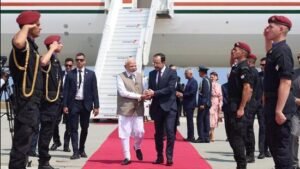
Why in News:
- Former US President Donald Trump, during his presidential campaign, reintroduced aggressive trade measures, slapping a 27% reciprocal tariff on Indian exports, with even higher duties on other Asian peers.
- This shift marks a dramatic turn in global trade dynamics, signaling the end of the traditional post-WWII globalisation order and the onset of a protectionist era.
Introduction:
This article reflects on the significant paradigm shift in global trade being led by Donald Trump through his “reciprocal tariffs” strategy. His decision to impose steep import tariffs on products from India and other Asian nations sent shockwaves across global markets. While the US justified the move as a reciprocal action to correct trade imbalances, it disrupted long-standing globalisation structures and raised concerns for export-reliant economies like India. This protectionist tilt also poses a major challenge to developing countries that have long depended on global access and trade liberalization for growth.
Point-wise Summary:
- Introduction of Reciprocal Tariffs:
- Donald Trump announced a 27% reciprocal tariff on Indian exports, which, though lower than the rate imposed on many Asian nations, still poses a challenge to India’s trade.
- Items like gems, jewellery, auto components, and solar modules are likely to be impacted.
- A New Phase of Protectionism:
- Trump’s tariff plan represents a reversal from decades of globalisation led by the US since the early 1990s.
- This shift underlines a broader rethinking of global trade rules, replacing free trade principles with aggressive national trade policies.
- Impact on Indian Exports:
- The 27% tariff may negatively affect Indian exports, particularly:
- Gems and jewellery
- Automobile components
- Solar photovoltaic modules
- Pharma, minerals, and some essential commodities received exemptions from these duties.
- Asian Countries Face Higher Tariffs:
- While India faces a 27% tariff, other Asian peers have been hit harder.
- This reflects a targeted strategy by the US to reduce dependence on Asian manufacturing powerhouses.
- Shockwaves Across Global Markets:
- The announcement triggered a massive market sell-off:
- Dow Jones fell by 3.4%
- Nasdaq dropped 5.8%
- Oil prices also slid by 6%
- Markets are reacting to fears of a full-scale trade war and global economic slowdown.
- India’s Cautious Response:
- India, adopting a cautious tone, emphasized the need to engage in discussions with the Trump administration to protect national interests.
- The Commerce Ministry is assessing the sector-wise impact and strategizing appropriate policy responses.
- Silver Linings for India:
Despite the tariff blow, the situation offers certain opportunities for India:
- Trade Negotiation Space: India now has leverage to negotiate trade terms more aggressively.
- Reform Momentum: Pressure from external economic policies can push India towards key economic and trade reforms.
- Global Trade Realignment: India may benefit from shifting supply chains away from China and increased Western interest in Indian manufacturing.
- Historical and Strategic Context:
- Trump’s approach is described as “economic nationalism”, breaking away from the liberal global trade order established post-WWII.
- He aims to protect domestic industries and reduce trade deficits, resonating with his traditional voter base.
- Trump’s Trade Philosophy – “America First”:
- Emphasizes fairness in trade, promoting “reciprocity” over “free trade”.
- Seeks to penalize countries that, in Trump’s view, exploit the US’s open market access without offering equivalent openness.
- Reactions from US Industry:
- Trump’s measures received mixed reactions:
- Some industries, especially traditional manufacturing and auto sectors, welcomed the move.
- Tech and export-reliant companies expressed concerns over retaliatory actions by other countries and loss of global competitiveness.
Notes (Explanation of Peculiar Terms):
- Reciprocal Tariffs:
Tariffs imposed to match or counter similar tariffs set by another country. It aims at equalizing trade conditions.
- Protectionism:
An economic policy that restricts imports through tariffs or quotas to protect domestic industries from foreign competition.
- Globalisation:
The process of increased interconnectedness and integration of economies, cultures, and societies through free trade, investment, and information exchange.
- Trade Deficit:
Occurs when a country imports more than it exports. The US has long maintained a significant trade deficit with Asian nations.
- Comparative Advantage:
The ability of a country to produce goods or services at a lower opportunity cost than others. This principle is the basis of free trade theory.
- Solar Photovoltaic Modules:
Components used in solar panels to convert sunlight into electricity, a key Indian export in the renewable energy sector.
- Nasdaq and Dow Jones:
Major US stock market indices. Their movement reflects investor sentiment towards policy decisions and economic indicators.
- Economic Nationalism:
A policy approach that emphasizes domestic control of the economy, labor, and capital formation, often at the expense of global cooperation.
Relevance for CLAT Aspirants:
- Current Affairs & GK:
- Trade relations, tariff policies, and US-India economic diplomacy are frequent topics in CLAT’s current affairs section.
- Legal and Economic Awareness:
- Understanding international economic policies, trade laws, and their consequences can help in answering GK-based legal questions.
- Essay Writing/PI Rounds:
Potential essay topics or interview questions may include:
- “India in a Protectionist World”
- “Impact of Global Tariff Wars on Developing Nations”
- “Is Globalisation Dead?”
- Logical and Analytical Reasoning:
- The policy shift from liberal trade to protectionism challenges aspirants to think critically and assess both short-term disruptions and long-term gains.
Conclusion:
The announcement of Trump’s reciprocal tariff regime marks a seismic shift in the global trade environment, replacing open market policies with protectionist nationalism. For India, the immediate concern is the negative impact on labour-intensive exports like jewellery and auto parts. However, this challenge comes with an opportunity to revamp trade strategies, accelerate domestic reforms, and explore new market alignments. As global trade undergoes a realignment, India’s policy agility and diplomatic balancing will be key to turning adversity into advantage.






